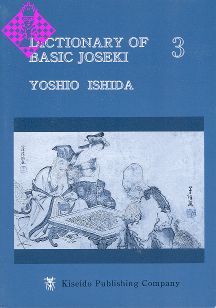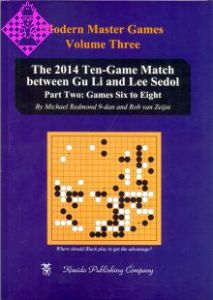Article Number
LGISHDOBJ3
Author
Dictionary of Basic Joseki 3
303 pages, paperback, Kiseido, 1977
Discontinued
This brilliant and original survey of josekis, written by a top Japanese professional, is not only a practical, well-organized reference to help you chart your course through the myriad complications of standard josekis, but it is also an illuminating analysis of their vital components such as tesuji and shape. It covers all important josekis and also deals with mistakes and alternatives in josekis. It is equally valuable as a reference work and as a primer in the fundamentals of go theory which underlie josekis.
| EAN | 4906574238 |
|---|---|
| Weight | 412 g |
| Manufacturer | Kiseido |
| Width | 14.7 cm |
| Height | 21 cm |
| Medium | Book |
| Year of Publication | 1977 |
| Author | Yoshio Ishida |
| Language | English |
| ISBN-10 | 4906574238 |
| Pages | 303 |
| Binding | paperback |
viii Foreword
ix Japanese Terms
002 THE 5-4 POINT
002 Part Eight: The 3-4 Approch
057 Part Nine: Entering at the 3-3 Point
065 THE STAR POINT
065 Part Ten: The Small Knight Approach
206 Part Eleven: The One-Space High Approach
211 Part Twelve: The Two-Space High Approach
220 Supplement: Positions with No Approch Move
242 THE 3-3 POINT
242 Part Thirteen: The Shoulder-Hit
249 Part Fourteen: The Large Knight Approach
ix Japanese Terms
002 THE 5-4 POINT
002 Part Eight: The 3-4 Approch
057 Part Nine: Entering at the 3-3 Point
065 THE STAR POINT
065 Part Ten: The Small Knight Approach
206 Part Eleven: The One-Space High Approach
211 Part Twelve: The Two-Space High Approach
220 Supplement: Positions with No Approch Move
242 THE 3-3 POINT
242 Part Thirteen: The Shoulder-Hit
249 Part Fourteen: The Large Knight Approach
This final volume covers the 5-4, 4-4 and 3-3 points. Like the 5-3 point, the 5-4 point was popular in classical Go and so a considerable amount of research was carried out on it. Though occasionally played in classical Go, however, it was not until recent times that the star-point and the 3-3 point were properly utilized in actual play and their true value recognized. The reader should appreciate that these moves are essentially different in nature from the 5-3 and 5-4 points. The latter do not finish with the corner in one move -if the opponent does not make an approach move, one's objective is clearly to secure the corner by adding another move. An approach move preventing this is therefore of considerable value and should be played as early as possible. Plays at the star-point and the 3-3 point, on the other hand, finish with the corner in one move. Even if one wants to add an extra move in the corner, there is no appropriate continuation. Any enclosing move made in conjunction with one of these two points is inferior in efficiency to enclosing from the 3-4, 5-3 or 5-4 points. As compensation, however, one can dispense with enclosing the corner and extend along the side immediately. Moreover, the principal advantage of the star-point and the 3-3 point is that they are not biased in either direction, so one can choose freely which way one wants to extend. In other words, one can aim at a rapid fuseki development, especially with the star-point. It is perhaps only natural, therefore, that the star-point has become so popular in modern Go, with its emphasis on speed. In the past the star-point was regarded merely as a handicap stone, but in modern Go it has undergone a transformation and been reborn.
The 3-3 point was formerly regarded as a taboo point in the fuseki. However, its virtues in securing the corner with one move have been reevaluated and it is often played by White in komi games. Each point has its virtues, provided that one knows how to take proper advantage of them, so one cannot say that one is better than another.
I personally believe that there are no star-point or 3-3 point joseki. The reason is that one should freely modify one's approach according to the overall position, since being bound by set patterns may destroy the originality of one's game. However, I have no intention of forcing my views upon the reader. I have done my best to assemble not only all the established joseki patterns but also the most recent innovations from actual play.
If the three volumes of this joseki dictionary become a close companion to the reader and prove of assistance in his studies, I will feel amply rewarded for my labours.
Ishida Yoshio February 1976, foreword
The 3-3 point was formerly regarded as a taboo point in the fuseki. However, its virtues in securing the corner with one move have been reevaluated and it is often played by White in komi games. Each point has its virtues, provided that one knows how to take proper advantage of them, so one cannot say that one is better than another.
I personally believe that there are no star-point or 3-3 point joseki. The reason is that one should freely modify one's approach according to the overall position, since being bound by set patterns may destroy the originality of one's game. However, I have no intention of forcing my views upon the reader. I have done my best to assemble not only all the established joseki patterns but also the most recent innovations from actual play.
If the three volumes of this joseki dictionary become a close companion to the reader and prove of assistance in his studies, I will feel amply rewarded for my labours.
Ishida Yoshio February 1976, foreword
More from Kiseido
-
 Bookshelf One€44.95
Bookshelf One€44.95


